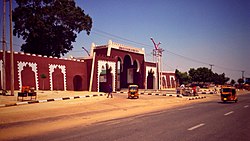| Ancient Kano City Walls | |
|---|---|
 Sabuwar Kofa, one of the city gates | |
| Type | Defensive wall |
| Location | Kano Nigeria |
| Coordinates | 11°57′20″N8°29′51″E / 11.9555°N 8.49754°E |
| Height | 50 feet (15 m) |
| Built | 1095–1134 |
| Built for | Defence |
| Governing body | Kano State Tourism |
The Ancient Kano City Walls (Hausa: Ganuwa) were ancient defensive walls built to protect the inhabitants of the ancient city of Kano. [1] [2] The wall was initially built from 1095 through 1134 and completed in the middle of the 14th century. The Ancient Kano City Walls were described as "the most impressive monument in West Africa". [3]

